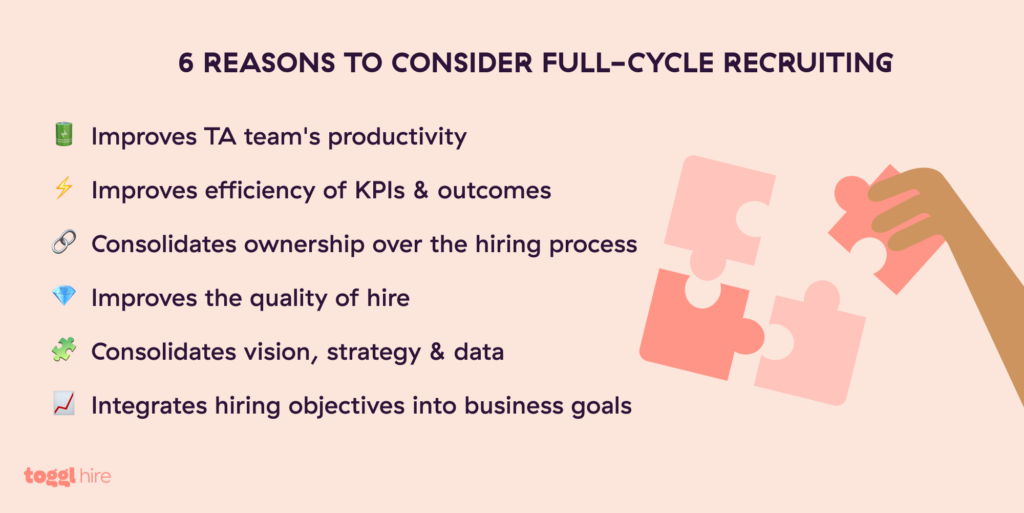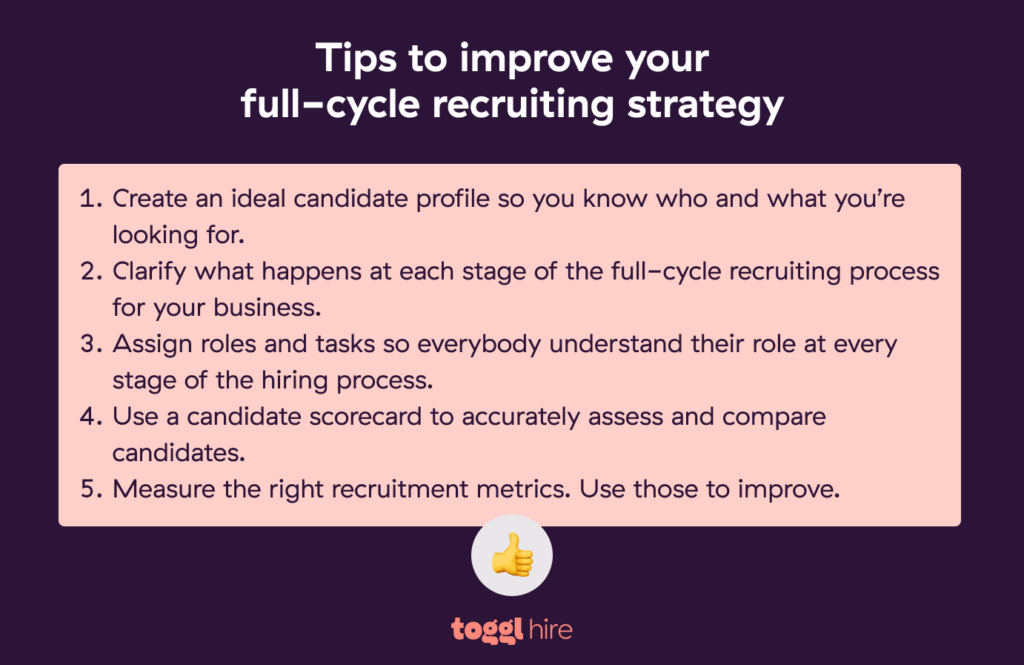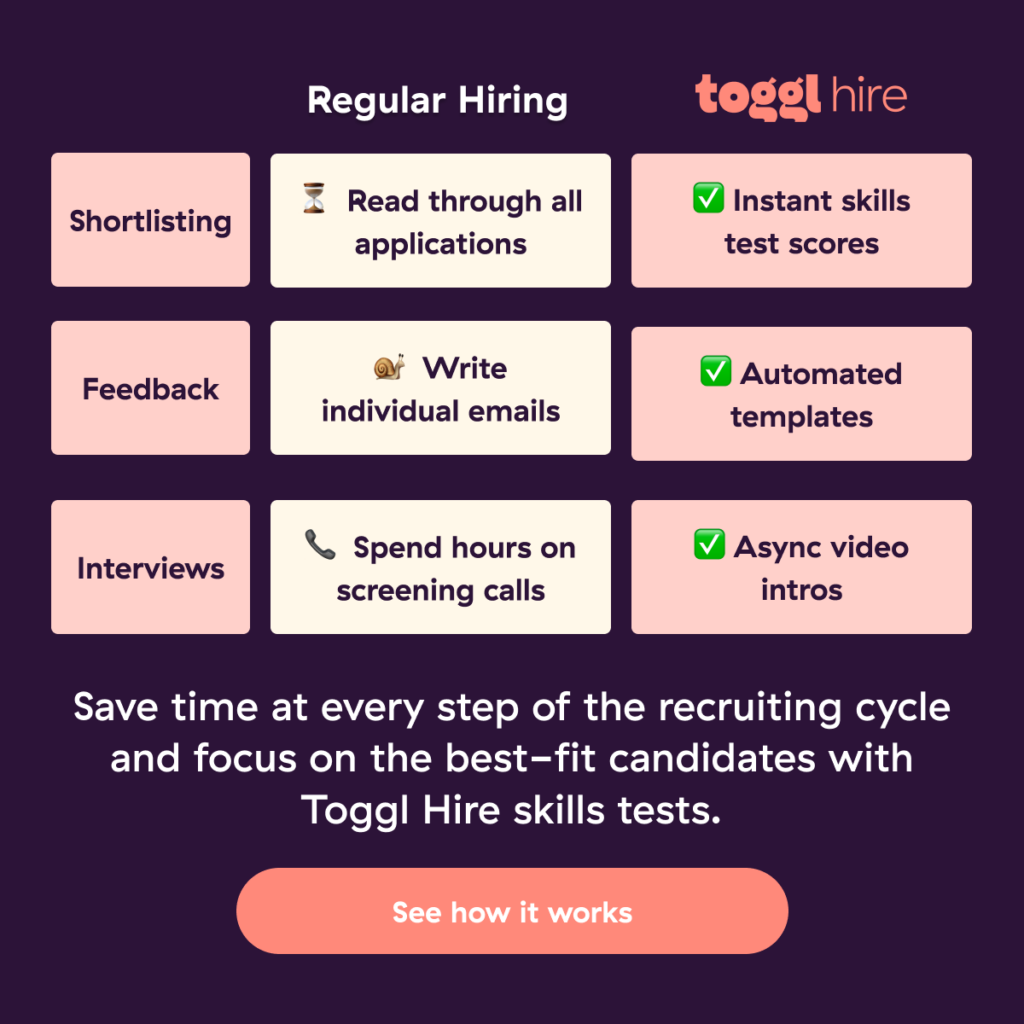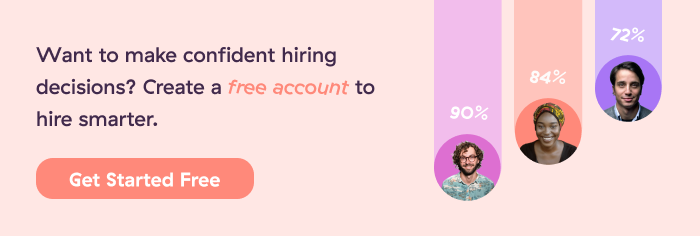As the job market continues to evolve, so does the recruitment process. Gone are the days when a simple job posting would bring in a flood of qualified candidates. Now, recruiters must go above and beyond to attract top talent.
Part of going “beyond” includes improving hiring efficiencies to separate your company and its opportunities from the rest. The best way to achieve hiring efficiency and hook great candidates is by using full-cycle recruiting to screen, filter, assess, and select the perfect candidates for every role.
When you engage in end-to-end recruiting, it’s easier to learn from recruitment wins (and mistakes) to ensure talent acquisition never stagnates. Each new hire drives further improvement — allowing you to stay one step ahead of the competition.
TL;DR — Key Takeaways
Full-cycle recruiting takes a holistic approach to the recruitment process. Unlike traditional recruiting, a single person manages the entire cycle, from advertising roles and sourcing candidates to interviews, assessments, and onboarding.
For smaller firms, full-cycle recruiting gives equal weight to each stage of the recruitment process. Larger organizations benefit from a consistent, measurable process, ensuring every recruitment campaign meets the highest standards.
Potential drawbacks of full-cycle recruiting include demanding workloads and the need to hire specialist recruiters. Life cycle recruiting at scale is complex, making it best suited to medium-sized workplaces with relatively fewer job openings.
There are usually six full-cycle recruitment stages. Recruiters prepare job descriptions and design roles carefully. Then, they source candidates before screening applications to meet business needs. Finally, they select suitable hires, negotiate job offers, and handle onboarding.
Companies can improve their recruitment process with candidate profiling, interview scorecards, and the intelligent use of recruitment metrics. Using recruiting software can also help manage every stage and avoid human errors.

What is full-cycle recruiting?
Traditional recruiting tends to separate the hiring process into separate chunks, with specialist roles for candidate scouts, interviewers, and onboarding officers. Full-cycle recruiting is a complete end-to-end process that ends with the candidate accepting a job offer.
Full-cycle recruiters, therefore, handle every step in the recruitment process, from creating and posting a job description to advertising the opening, screening candidates, performing background checks, and, finally, employee onboarding.
Who uses the full life cycle recruiting process (and why)?
Many companies employ full life cycle recruiting, from startups to globe-spanning corporate entities. However, they use the effective recruitment process in different ways:
Small and medium-sized companies may not have the resources to assign separate specialists to each recruiting stage (most don’t even have an HR department), so it makes sense for one hiring manager to oversee the full recruitment cycle, from advertising roles to choosing hires.
Larger organizations commonly have hiring teams with at least one dedicated full-cycle recruiter. This person is responsible for managing the entire recruitment process. The full-cycle hiring manager works with specialists for candidate sourcing, assessment, or onboarding.
Larger companies can toggle their recruiting setup and ensure every stage of the recruitment process receives the same attention. This leads to a consistent and quality candidate experience.
No matter how large a company is, though, HR managers have two options when adopting a full-cycle recruiting approach — keeping the process in-house or using an agency:
In-house recruiters understand the company’s culture, policies, and needs. They usually find it easy to align full life cycle recruiting with company objectives. This method is better if you want to maintain close control over your company culture and workplace atmosphere.
Agencies or contract recruiters are sometimes more cost-effective and allow internal HR teams to focus on other tasks while dedicated professionals handle the entire recruitment process. Good agencies deliver candidates according to client needs. However, there is always a risk of losing control when using third-party recruiters.

Who is responsible for full-cycle recruiting?
Full-cycle recruiting is usually the job of one recruiter, especially in small to medium-sized HR departments and hiring teams. Larger organizations may share responsibility among various relevant departments and personnel. Even so, the HR department leads and oversees each step.
Regardless of whether or not your company has a dedicated full-cycle recruiter on board, other departments or personnel may join the recruiting process.
In this sense, full-cycle recruiting is also full-spectrum recruiting. Whether you have multiple recruiters or just one, the goal is always to optimize recruiting decisions.
Full-cycle recruiting vs. on-cycle recruiting
Before we explore how full-cycle recruiting works, it’s helpful to clear up one common point of confusion — the difference between “full-cycle” and “on-cycle” in the recruiting process.
On-cycle recruiting fills open positions within a specified time frame or hiring cycle. The goal is usually to fill positions to meet an organization’s regular staffing needs.
Full-cycle recruiting covers the entire process of identifying, sourcing, evaluating, and hiring candidates. This includes both on-cycle and off-cycle recruiting, as well as any other activities related to finding qualified candidates for open positions.
Additionally, full-cycle recruiting can include efforts to fill positions outside of regular staffing needs, such as temporary or contract positions.
Put another way, the on-cycle recruiting process dictates when companies hire. Full-cycle recruiting is a holistic way of organizing how companies hire.
The full-cycle recruiting process
The six stages of full life cycle recruiting include preparing, sourcing, screening, selecting, hiring, and onboarding a new hire. This comprehensive process may use both on and off-cycle recruiting to find and hire the ideal candidate. But it usually follows a similar schedule.

Preparation
The preparation phase involves identifying the skills and experience candidates need to be successful in the position. This starts with a job requisition, which may include conducting a job analysis to determine the duties and responsibilities of the role.
After the requisition approval, the role gets passed on to a full-cycle recruiting officer. The process manager must create a job description outlining the requirements and qualifications for the position.
This is an important step in the process as it closely informs the final preparation task: writing attractive job postings. The hiring manager may enlist a copywriter to ensure the job ad reads well. It also helps to consult senior colleagues for their opinions.
Sourcing
The second stage of full-cycle recruiting is to source candidates. This may involve various sourcing techniques, such as researching and posting on job boards, employee referrals, social media, and targeted recruiting campaigns.
Ideally, full-cycle recruiters use highly focused candidate sourcing methods. Maintaining a diverse and healthy talent pool is also really helpful. Full-cycle recruiters can log applicant details, informal contacts, or even those leaving the organization. Segmenting the pool into different technical skills or specialties helps when sourcing candidates in the future.
Screening
Once you’ve identified potential candidates, the next stage is to screen and evaluate their qualifications and fit for the role. This involves reviewing resumes and cover letters, conducting phone or video interviews, and using assessments or other evaluation tools.
Screening can be time-consuming for full-cycle recruiters with limited time and resources. However, it’s vital to eliminate poor candidates and progress individuals with desirable skills or experience. Role-specific pre-selection skills tests can help you identify high-potential candidates.
The key aim is to use whatever tools you need to convert a pile of resumes into a list of quality, qualified candidates.
Selection
The next step in the full recruitment life cycle involves conducting in-person or virtual interviews with top candidates to narrow the selection process.
Full-cycle recruiters must work closely with hiring managers or departmental heads to optimize the interview process, who can help create candidate assignments, skills test requirements, interview questions, and how to analyze candidate feedback.
Creating an interview guide for this step is a good idea, as it helps manage the candidate experience and sets out clear procedures for recruiters.
Hiring
If you’ve selected a suitable candidate, you’ll make a job offer. The offer stage might include some negotiation around salary, benefits, and working hours. If you’ve done your job well, though (and make everything clear in the job description), most of the basics should have been covered at the start.
This stage is usually when companies conduct background and reference checks to verify candidate qualifications and employment history. Checks usually precede the formal offer, giving companies a last chance to change their mind or (only in the worst cases) restart the recruiting process.
Onboarding
After candidates accept the position, the final stage of full-cycle recruiting is the onboarding process. This hiring stage involves introducing the new hire to the team and bringing them up to speed on their new job.
Recruiters remain engaged during pre-boarding and the onboarding process. Depending on the size of the company, they might also be the main point of contact for new hires before beginning their role. They may even help with practical issues such as remote work setup or relocation.
Benefits of full-cycle recruiting
Easier and faster turnaround time when hiring new employees because the same person is responsible for all aspects of the process. This also leads to increased accountability.
Better qualified candidates, especially for hard-to-fill roles. Personalizing the hiring process means recruiters better understand corporate and candidate needs. They can focus on finding a qualified candidate who suits the company culture.
Significant increase in consistency during the recruitment cycle, as all candidates will be evaluated using the same criteria.
Better candidate experience because the recruiter can provide 360 feedback throughout the life cycle recruitment process while building a meaningful relationship.
The right role and culture fit due to a consistent hiring process that leads to a greater likelihood of hiring the ideal candidate who fits both the role and the company culture.
🤔 Still not convinced? If not, these business cases highlight some great full recruiting cycle benefits for hiring managers:
Quality candidates: Companies can better control the quality of candidates by managing the full-cycle recruitment process in-house.
Productive workforce: Better talent acquisition leads to a more productive and engaged workforce, positively impacting team morale and boosting revenues.
Leaner company finances: A robust and efficient life cycle recruitment process can positively affect the company’s bottom line.
Attract top talent: A robust full-cycle recruitment process can aid in acquiring the best talent.
Reduce turnover costs: Optimizing the full recruitment cycle can help decrease the costs associated with high turnover rates.

Drawbacks of full-cycle recruiting
The list of benefits above makes a strong case for implementing full life cycle recruitment, but don’t rush to update your hiring processes just yet. There are also a few potential drawbacks to consider:
Hiring volume can cause problems when companies must recruit large numbers of people. One person should ideally only handle a few candidates at a time. If you’re mass hiring, you’ll need to consider another hiring strategy or have more full-cycle recruiters on board.
The full-cycle recruiting process demands a wide range of skills. Recruiters need to manage sourcing, assessments, interviews, and onboarding. Not everyone has the capabilities to excel throughout the recruitment process. Many companies rely on specialized roles in their recruiting team.
Communication issues. Recruiters need to communicate with multiple candidates and hiring managers, not to mention department heads or recruitment platforms. Keeping everyone on the same page during the entire process can be tricky if they don’t have the right communication skills.
5 tips for improving your full-cycle recruiting strategy
The hardest part of mastering the full recruitment life cycle is getting started. It takes time to refine your processes and embed them in company practices. With that in mind, the five tips below will make implementing full life cycle recruitment much easier.

1. Create an ideal candidate profile
When preparing your job requisition and initial job description, model your requirements around a candidate persona. Think about the kind of person each role requires. What unique skills and personality traits should the ideal candidate have?
Write a short description of the perfect applicant. Use this as a reference point during the full life-cycle recruitment pipeline. You may not find a mirror image, but if you know what to look for, you can get pretty close.
2. Assign roles and tasks
A team-based approach to life cycle recruiting defines roles and responsibilities from the outset. Everybody involved should know their roles at every stage of the recruitment process, whether screening candidates, assessing test results, or delivering onboarding packs.
Creating flow diagrams and policies to define responsibilities is a solid end-to-end recruiting best practice. Remember, the idea is to deliver a consistent process. Consistency demands similar processes every single time.
3. Clarify stages of the hiring process
Here’s another often-overlooked fundamental: understanding stages in the recruitment cycle. Try to follow the six-stage model outlined earlier and decide where each stage starts and ends.
For example, sourcing might conclude when the recruiter has a copy of the internal job description. Screening ends when you have a list of candidates for follow-up interviews, while selection ends with a formal job offer.
4. Use a candidate scorecard
Consistency is crucial in the life cycle recruiting process, especially when collecting data about candidates. Using candidate scorecards for interviews can make all the difference because they make it much easier to record how candidates rate on hard and soft skills.
They aren’t infallible, as personal biases can creep in. However, scorecards do provide a consistent framework for assessing interview performance (and you can work around biases by pairing them with candidate skills tests).
🔥 You don’t have to build your candidate scorecard from scratch. Download our FREE scorecard template for interviews.

5. Measure the right metrics
Without solid data, how do we know whether hiring processes deliver value for money and help find the ideal candidates? Leverage multiple data points to understand how your process is working. Some options include…
Source of hire: Tracking source of hire focuses attention on high-value sourcing methods.
Cost per hire: Tracking the cost of hiring an employee is always valuable, highlighting ways to save on software, advertising, administration, and other hiring costs. But cost-per-hire is even more powerful if you combine it with…
Quality of hire: Higher hiring costs can be okay if recruiters deliver better candidates. Monitoring cost and quality together helps you understand whether your full-cycle recruiting process is firing (or hiring) on all cylinders.
Candidate metrics: Declining offer acceptance or interview-to-offer rates may indicate flaws in your employee proposition or recruitment techniques.
Time to hire: Sometimes, the recruitment process falls apart as recruiters become overwhelmed by tasks. An increasingly longer time to hire is often an early warning sign of that. If the average time increases, look at ways to ease the load on recruitment teams.
Full-cycle recruiting technology
Cutting-edge software makes it easier to manage hiring tasks, schedule stages in the recruitment cycle, and improve quality control. Each stage of the recruitment process has its companion tools. Examples to think about include:
Preparation: Instead of relying on copy editors, use grammar and flow checkers like Textio to iron out creases and streamline job descriptions or ads.
Scouting: AI-powered tools like HireEZ scout candidates and produce shortlists, saving HR teams a lot of mundane labor.
Selection: Use calendar tools like Rooster to ensure candidate availability and manage hectic interview schedules. And leverage skills testing platforms to assess candidate abilities.
Screening and reference checking: Checkmate is the ideal tool for verifying candidate credentials.
Onboarding: Tools like CharlieHR deal with basic tasks like logging ID, meeting compliance requirements, and activating user privileges. HR teams can focus on providing a smooth experience for new hires.
General tools: If you prefer an all-in-one solution, consider installing an applicant tracking system (ATS). ATS software pools functions like scheduling, advertising roles, collaboration, and testing candidates.
Simplify full-cycle recruitment with Toggl Hire
As a full-cycle (or potential full-cycle) recruiter, your goal is to make the right hires and set them up for success in the organization. This requires you to identify the qualifications and experience a position requires, find the right candidates, make a hiring decision, and onboard the successful applicant.
Sound like a lot? Maybe. But if you use Toggl Hire as your trusted tool, the challenge won’t feel too overwhelming:
Screen faster with skills tests. Pick from a library of pre-built technical and soft skills assessments and customize them to match your job requirements.
Integrate automation. Set up a pass threshold to create a minimum pass score as the first step in identifying the best potential candidates — then have your skills tests graded automatically.
Run asynchronous intro interviews. Use Video Intros to set up and automate initial candidate screening via video. Create an intro video to give candidates a better understanding of the role and the organization, then pick up to three questions from the video question pool and let candidates send in their video answers.
Distribute homework assignments. Make candidate shortlisting effortless with a data-driven selection process: use take-home assignment templates to evaluate job-specific skills at later recruitment stages.
Collect feedback. Keep everyone on the same page with shared notes and candidate ratings to drive better hiring decisions.

Start full-cycle recruiting
When done right, a skilled life cycle recruiter increases hiring quality and reduces the risk of expensive recruitment mistakes. However, consolidating the hiring process comes with certain risks.
Using hiring tools that reduce costs and meet recruitment goals is essential. And for that, you’ll want to try Toggl Hire. We make it easier to cover most areas of the recruitment process at once, saving you a lot of time and effort and thus allowing you to focus on sourcing, assessing, and hiring your ideal candidate.
Create a free account today to test our tools and skills tests. With plenty of customization options, they offer the perfect route to effective full-cycle recruiting.

Elizabeth is an experienced entrepreneur and content marketer. She has nine years of experience helping grow businesses and has experienced first-hand the impact of skills-based hiring in today's global, digital world.




